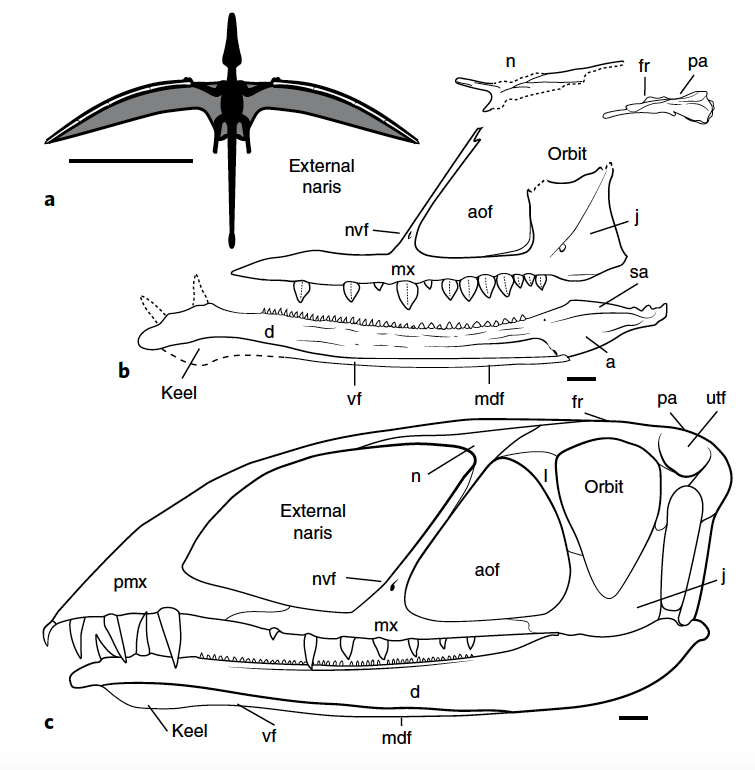New Pterosaur Species Discovered In Utah Desert Had A Pelican-Like Pouch
Language
Reading Level
Listen to Article

About a decade ago, Brigham Young University paleontologists stumbled upon thousands of fossils at the Saints and Sinners quarry, an ancient, dried-up water hole, in northeastern Utah. Since there were too many to extract at the site, the team, led by Brooks Britt, cut the slabs of sandstone in which the bones were preserved and took them to the laboratory. Over the years, they have identified the remains of several late Triassic inhabitants, including several sphenosuchians - small crocodile-like creatures – and two carnivorous dinosaurs. However, the most exciting discovery was that of a new species of pterosaur that dates back over 200 million years, when supercontinent Pangea was still intact.
What made the find even more significant was how complete, and well-preserved, the fossils were. “Most Triassic specimens consist of just a single bone: for example, a little phalanx from a finger or one vertebra from the neck,” Britt said. “For this animal, we have the sides of the face and the complete roof of the skull, including the brain case, complete lower jaws and part of the wing.”

The rare pterosaur was first unveiled in 2015 at the 75th Annual Society of Vertebrate Paleontology meeting in Dallas, Texas. The researchers reported that the creature had a 4.5-to-5-foot (1.3 to 1.5 meters) wide wingspan and 110 teeth – 80 (including four fangs) on the lower jaw and 30 on the upper one. They also believed its massive head, which was proportionately larger than the body, made it impossible for the reptile to fly long distances. This led Britt’s team to conclude that the pterosaur probably scooped up its prey – small, land-dwelling animals – from the surrounding trees or the watering hole where the fossils were discovered.
The researchers have since built a 3-D printed model of the pterosaur's skull using CT scans of the delicate fossils, still encased in the limestone, to gain new insights into the ancient creature. In a report published in the journal Nature Ecology and Evolution on August 13, 2018, the scientists revealed that the reptile, named Caelestiventus (“heavenly wind”) hanseni, was the largest Triassic-era pterosaur and had good eyesight, but a poor sense of smell. The bony crest on its lower jaw indicates it featured a pelican-like pouch. However, given that its desert oasis did not have any fish, it was most likely used to carry small land animals or make vocalizations.

More importantly, C. hanseni, which predates the previous desert specimen discovered by 65 million years, is the oldest desert-dwelling pterosaur ever discovered. All the other Triassic-era pterosaur fossils have been found in what used to be coastal areas in Greenland and Europe. The fact that C. hanseni was able to survive in what was once a vast desert suggests that the flying reptiles were evolving and moving into specialized ecological niches earlier than previously believed.
Based on the shape of its skull, the researchers believe C. hanseni is most closely related to D. macronyx, a pterosaur which lived in the area that is now Britain during the Jurassic period. That animal, however, thrived in a humid island climate, which was very different from C. hanseni’s arid world. Britt and his team believe it was probably the ability to adapt to different environments that enabled pterosaurs to survive the end-of-Triassic mass extinction, which decimated half of the land and marine species.
Though pterosaurs are often referred to as “flying dinosaurs,” experts say that classification is scientifically incorrect and instead prefer to call them the “first flying vertebrates.” That's because though the creatures lived and perished alongside dinosaurs and can even be considered close cousins, they evolved from a separate branch of the reptile family tree. And in case you are wondering, pterosaurs are not related to birds or bats either!
Resources: livescience.com. smithsonianmag.com, blog.discovermagazine.com, phys.org

Get the Workbook for this article!
Workbook contains: Article, Reading Comprehension, Critical Thinking Questions, Vocabulary in Context (+ answers), Multiple Choice Quiz (+ answers), Parts of Speech Quiz (+ answers), Vocabulary Game (+ answers)Cite Article
Learn Keywords in this Article
466 Comments
- Ewok_Heroabout 6 yearsso super cool
- chlooeabout 6 yearsSo cool, ya'll should know this.
- hello yall about 6 yearsthis so cool
- hwabout 6 yearsso cool
- jellabout 6 yearsits cool
- ari-dogabout 6 yearskinda gross but still cool
- MHabout 6 yearswow thats awsome
- cwabout 6 yearsthat thing is scary but kinda co
- vnhviowhviewovabout 6 yearsreally cool! Pterasaurs are one of the coolest animals on the planet!
- wiltonabout 6 yearswow i never seen nothing like that




